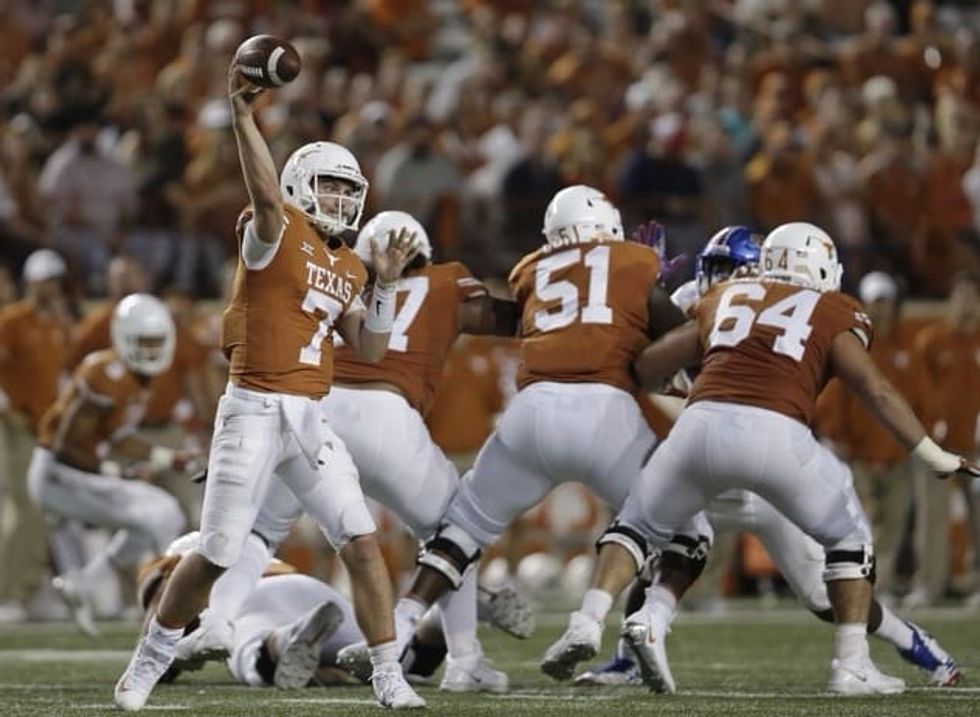HOOK THAT MONEY
New study says UT football players would make big money if paid like pros
John Egan
Nov 21, 2017, 11:51 am

Originally appeared on CultureMap/Austin.
College athletes don’t collect paychecks the way their counterparts in the pros do. But if they did, University of Texas at Austin football players would score big.
New data from Business Insider indicates the average Longhorn football player would rake in an estimated $666,029 a year, based on the UT football program’s average annual revenue of $120.5 million over the past three years. That’s the highest per-player market value among the country’s 20 most profitable college football programs.
In case you were wondering, UT’s head football coach, Tom Herman, is poised to pull in $28.75 million in basic compensation under his current five-year contract.
Using figures from the U.S. Department of Education and Ellen Staurowsky, a professor at Drexel University’s Center for Sport Management, Business Insidercalculated how much the typical player in each of the top 20 football programs would be worth if he were compensated like an NFL player. Business Insiderarrived at the estimates by applying the current minimum that NFL players receive and splitting that share evenly among each team’s 85 scholarship players.
On average, a player who competes at a school in the NCAA’s Division I Football Bowl Subdivision (the top tier of college football programs) is worth $163,087 a year, according to Business Insider.
At No. 2 on the list is the University of Alabama, where the average football player is worth $545,357 a year. Next is the University of Michigan ($510,153), followed by the University of Tennessee ($501,260) and the University of Notre Dame ($488,833).
Down the list are two of UT’s most despised foes: the University of Oklahoma and Texas A&M University. OU ranks eighth, with a per-player value of $450,185, and A&M ranks 14th, with a per-player value of $356,875.
While UT’s standing on the Business Insider list may offer bragging rights for the Longhorns, the university’s football players shouldn’t be banking on a six-figure paycheck, at least in the foreseeable future.
UT President Greg Fenves has been quoted as saying that he “cannot comprehend” how student-athletes could be paid beyond their scholarships. If UT athletes were paid, Fenves fears that alumni would perceive the university as “just another professional sports team.”
State Rep. John Kuempel, a Seguin Republican who played football at UT, sides with Fenves. At a 2015 panel discussion about paying student-athletes, Kuempel said:
“I disagree with having paid players. What is the percentage of people who go on to make money in professional sports? It’s miniscule. Once you start paying athletes, they will not pay attention to what’s going to keep them afloat for the rest of their lives. In the end, sports are there to teach you what to do with the rest of your life.”
Toward the other end of the field on this issue is the National College Players Association. A 2013 study by the association and Drexel University argues that student-athletes — especially football players — aren’t fairly compensated for their market value.
“The business practices of the NCAA and major conferences governing big-time football suggest that they … own the players,” the study says. “Findings from this study offer an indictment of the principle of amateurism used by the NCAA to enforce a system that distributes the wealth generated by big money college sport programs away from the players and redirects it to coaches, administrators, conference commissioners, bowl executives, colleges and universities, and corporate entities.”
Oswald Peraza hit a two-run single in the ninth inning to help the Los Angeles Angels snap a three-game losing skid by beating the Houston Astros 4-1 on Saturday night.
Peraza entered the game as a defensive replacement in the seventh inning and hit a bases-loaded fly ball to deep right field that eluded the outstretched glove of Cam Smith. It was the fourth straight hit off Astros closer Bryan Abreu (3-4), who had not allowed a run in his previous 12 appearances.
The Angels third run of the ninth inning scored when Mike Trout walked with the bases loaded.
Kyle Hendricks allowed one run while scattering seven hits over six innings. He held the Astros to 1 for 8 with runners in scoring position, the one hit coming on Jesús Sánchez’s third-inning infield single that scored Jeremy Peña.
Reid Detmers worked around a leadoff walk to keep the Astros scoreless in the seventh, and José Fermin (3-2) retired the side in order in the eighth before Kenley Jansen worked a scoreless ninth to earn his 24th save.
Houston’s Spencer Arrighetti struck out a season-high eight batters over 6 1/3 innings. The only hit he allowed was Zach Neto’s third-inning solo home run.
Yordan Alvarez had two hits for the Astros, who remained three games ahead of Seattle for first place in the AL West.
Peraza’s two-run single to deep right field that broke a 1-1 tie in the ninth.
Opponents were 5 for 44 against Abreu in August before he allowed four straight hits in the ninth.
Astros RHP Hunter Brown (10-6, 2.37 ERA) faces RHP José Soriano (9-9, 3.85) when the series continues Sunday.
